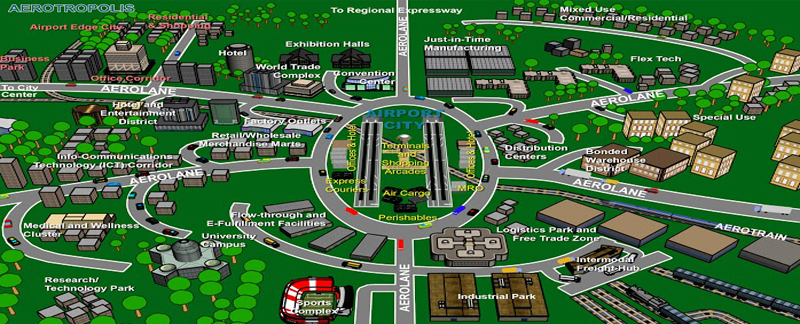Airports, like cities are never static. They are constantly evolving in form and function. Historically, airports have been understood as places where aircraft operate that include runways, control towers, terminals, hangers and other facilities which directly serve aircraft, passengers and cargo. This traditional understanding is giving way to a much broader encompassing concept known as The Airport City, which has become the 21st century way for many airports. The Airport City or a Logistic Airport City model is grounded in the fact that their core aeronautical infrastructure, services and major airports have developed significant non-aeronautical facilities, services and revenue streams, while extending their commercial reach and economic impact well beyond traditional airport boundaries.
![]() In the year 2000 a principle of NLI joined forces with Dr. John Kasarda, assisting in the development of an internal process structure for the North Carolina Global TransPark (GTP). One of the first Aerotropolis in our country. They developed an internal routing operational process for the flow of air cargo freight moving throughout the airport effectively and efficiently. Not to mention, eliminated older outdated inefficient traditional operational processes from air cargo on passenger aircraft and air cargo freighters. In the process of this development (in the year 2000, one year before 911) NLI developed an embedded cargo security method of passenger operations (modus operandi) for air cargo going through passenger airports. This security protocol would be able to examine and inspect 100% of all air cargo packages, food and drinks moving throughout passenger airports and air cargo centers. This process will meet all the guidelines for the 911 commission; securing 100% of all air cargo in passenger airports.
In the year 2000 a principle of NLI joined forces with Dr. John Kasarda, assisting in the development of an internal process structure for the North Carolina Global TransPark (GTP). One of the first Aerotropolis in our country. They developed an internal routing operational process for the flow of air cargo freight moving throughout the airport effectively and efficiently. Not to mention, eliminated older outdated inefficient traditional operational processes from air cargo on passenger aircraft and air cargo freighters. In the process of this development (in the year 2000, one year before 911) NLI developed an embedded cargo security method of passenger operations (modus operandi) for air cargo going through passenger airports. This security protocol would be able to examine and inspect 100% of all air cargo packages, food and drinks moving throughout passenger airports and air cargo centers. This process will meet all the guidelines for the 911 commission; securing 100% of all air cargo in passenger airports.
Airport security measures have gone through significant changes in recent years. Notably, these changes have been driven largely by terrorist activities around the globe.
Developing a comprehensive security plan for each individual airport is complex and involves multiple stakeholders responsible for airport and air travel security (e.g., airport authorities and agencies, airlines, private enterprise and government). Developing cost effective plans to address the complexity and regulatory compliance of security requires a forward thinking approach that encompasses a holistic and technology based view of what a security plan should include to meet current and future needs.
For more information and a strictly confidential reply, please contact us.

